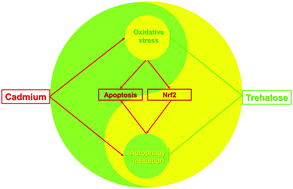Trehalose alleviates cadmium-induced brain damage by ameliorating oxidative stress, autophagy inhibition, and apoptosis
Abstract
Cadmium (Cd) is a persistent environmental contaminant and induces neurotoxicity in animals. Trehalose (Tre) exhibits powerful neuroprotective effects in certain brain injury models. Herein, we revealed the specific molecular mechanism underlying the protective effects of Tre against Cd-induced brain damage in rats. Firstly, the results showed that Tre significantly ameliorated brain pathological injury induced by Cd. Secondly, Cd-induced down-regulation of total anti-oxidation capacity (T-AOC) and up-regulation of methane dicarboxylic aldehyde (MDA) in brain tissues were significantly reversed by Tre treatment. Importantly, the augmentation of nuclear translocation of nuclear factor erythroid 2-related factor 2 (Nrf2) caused by Cd was significantly inhibited by Tre treatment. Thirdly, the levels of autophagy marker proteins were measured and the results showed that Tre significantly reversed the up-regulation of light chain 3II (LC-3II) and sequestosome 1 (SQSTM-1/p62) caused by Cd exposure. Finally, the apoptosis rate and the levels of apoptosis marker proteins including B cell leukemia/lymphoma 2 (Bcl2) and Bcl2-associated X protein (Bax) were also measured and the results showed that Cd-induced apoptosis was markedly inhibited by Tre treatment. Collectively, our data suggested that Tre exerted its neuroprotective effects by ameliorating oxidative stress, autophagy inhibition, and apoptosis induced by Cd in rat brains. In addition, the Nrf2 signaling pathway, which is continuously activated by Cd, may contribute to brain injury.



 Please wait while we load your content...
Please wait while we load your content...